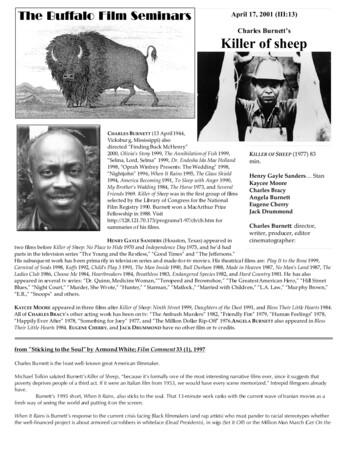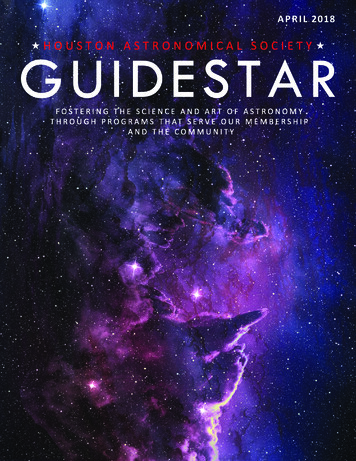
Transcription
April 17, 2001 (III:13)Charles Burnett’sKiller of sheepCHARLES BURNETT (13 April 1944,Vicksbur g, Mississippi) alsodirected “Finding Buck McHenry”2000, Olivia's Story 1999, The Annihilation of Fish 1999,“Selma, Lord, Selma” 1999, Dr. Endesha Ida Mae Holland1998, "Oprah Winfrey Presents: The Wedding" 1998,“Nightjohn” 199 6, When It Rains 1995, The Glass Sh ield1994, America Becoming 1991, To Sleep with Anger 1990,My Brother's Wedding 1984, The Horse 1973, and SeveralFriends 1969. Killer of Sheep was in the first group of filmsselected by the Library of Congress for the NationalFilm Registry 1990. Burnett won a MacArthur PrizeFellowship in 1988. Visithttp://128.121.70.173/programs/1-97/cb/cb.htm forsummaries of his films.KILLER OF SHEEP (1977) 83min.Henry Gayle Sanders StanKaycee MooreCharles BracyAngela BurnettEugene CherryJack DrummondCharles Burnett: director,writer, producer, editorcinematographer:HENRY GAYLE SANDERS (Houston, Texas) appear ed intwo films before Killer of Sheep: No Place to Hide 1970 and Independence Day 1975, and he’d hadparts in the television series “Th e Young and the Re stless,” “Good Times” and “ The Jeffersons.”His subseque nt work has b een prima rily in televisi on series an d made-fo r-tv movie s. His theatrica l films are: Play It to the Bone 1999,Carnival of Souls 1998, Kuffs 1992, Child's Play 3 1991, The Man Inside 1990, Bull Durham 1988, Made in Heaven 1987, No Man's Land 1987, TheLadies Club 1986, Choose Me 1984, Heartbreakers 1984, Breathless 1983, Endangered Species 1982, and Hard Country 1981. He has alsoappeared in several tv series: “Dr. Quinn, Medicine Woman,”“Tenspeed and Brownshoe,” “The Greatest American Hero,” “Hill StreetBlues,” “Night Court,” “ Murder, She Wr ote,” “Hunter,” “ Starman,” “Matlock ,” “Married with Childr en,” “L.A. Law,” “Mur phy Brown,”“E.R.,” “Snoops” and others.KAYCEE MOORE appeared in three films after Killer of Sheep: Ninth Street 1999, Daughters of the Dust 1991, and Bless Their Little Hearts 1984.All of CHARLES BRACY’s other acting work has been on tv: “The Ambush Murders” 1982, “Friendly Fire” 1979, “Human Feelings” 1978,“Happily Ever After” 1978, “Something for Joey” 1977, and “The Million Dollar Rip-Off” 1976.ANGELA BURNETT also appeared in BlessTheir Little Hearts 1984. EUGENE CHERRY, and JACK DRUMMOND have no oth er film or tv cr edits.from “Sticking to the Soul” by Armond White; Film Comment 33 (1), 1997Charles Bu rnett is the l east well- known great A merican filmmaker.Michael Tolkin saluted Burnett’s Killer of Sheep, “because it’s formally on e of the most interesting narrative films ever, since it su ggests thatpoverty deprives people of a third act. If it were an Italian film from 1953, we wou ld have every scene memorized.” Intrepid filmgoers alreadyhave.Burnett’s 1995 sh ort, When It Rains, also sticks to the soul. That 13-minute work ranks with the current wave of Iranian movies as afresh way of seeing the world and putting it on the screen.When It Rains is Burnett’s response to the current crisis facing Black filmmakers (and rap artists) who must pander to racial stereotypes whetherthe well-financed project is about armored car robbers in whiteface (Dead Presidents), in wigs (Set It Off) or the Million Man March (Get On the
Bus). For only 9,000 Burnett made a masterpiece about the disparate elements of a modern American community and the humane art – thegood humor – that binds it.Burnett’s output may not be widely known, but it challenges the loftiest, racist notion that white folks are keeping great film art tothemselves. Enhancing authentic images of working-class life with his personal understanding of how people interrelate, Burnett surpassesHollywood’s narrative conventions. His “realism” verges into surreal clarity about foible, mischief, tradition, and ambition, crystalized in Killer ofSheep’s scenes o f domestic s quabbles (’77), My Brother’s W edding’s street mugging a nd foot ch ase (’83), To Sleep With Anger’s family gatherings(’90) – all co mplicated by characters ’ ambivalence o r the pressu re of abundan t contradic tory lifehappening on the periphery.Burnett is the missing link in B lack consciou sness about film; Killer of Sheep and My Brother’s Weddingare independent of Hollywood in the same way Altman movies abjure genre for the more importanttruths of living and seeing. These two films represent the highest example of contemporary BlackAmerican life put on the sc reen because of Burnett’s integrity to view it purely, without typicalcorrupted Hollywood devices. The valor of his method is obscured by the recent Black Hollywoodfilms, from the dismal Straight out of Brooklyn to the new, terrible Love Jones – filmed by peoplepledged to Hollywood, and as Spike Lee wannabes, they copy Hollywood’s worst traits.Burnett’s cinema is tied to photography as a representational art, but cinema can also be evocative; evocation is its poetry when you see thetruth through stylization. At the time he made Killer, Burnett clearly didn’t trust th e latter method, and stuck to th e truth he knew, producing aphenomenal raw poetry, zeroing in on the blasted, pathetic nuis ances of racial oppression – a motor falling off a truck bed, a crippled, deaf girl’spregnancy. These things are shown as mundane and horrific, yet Burnett avoids melodrama so that he may document.There’s no higher view as in Ray , DeSica, Renoir or Altman – perhaps because tho se great artists had class (and rac e) privileges thatdistanced them from the meanness they respected, whereas a Black American filmmaker who isn’t ahustler still lives among us. But there is elevation in Little Walter in Killer of Sheep singing on thesoundtrack (“It’s a mean old world/ Try livin’ by yourself/ Can’t get the one you love/ Have to usesomeone e lse”), whic h proves a ha rsh view of life c an be compl ex and soph isticated. Pl ainly, Killer, withits central metaphor of sheep l ed to slaughter, scared off the nex t generation of Black Americanfilmmakers. Because Burnett’s metaph or was such a grim, multileveled truth, th ey recoiled rather thanlearn from it, only to get slaughtered b y Hollywood.From American Films of the 70sNtingela Masilela describes Charles Burnett as a member of the first wave of the “Los Angeles School” of African American and Africanindependent filmmakers. Other members of this group, who studied at UCLA in the 1970s are Haile Gerima, Ben Caldwell, Larry Clark,Jamaa Fanaka , Billy Mayberry, and the cr itic/historian Teshome Ga briel. The importanc e of the university setting was twofold: (1) itprovided an opportunity for screening, discussion, and practice of non-Hollywood approaches to narrative film; and (2) the members ofthe group inspired each other and helped each other to make feature films. . .this group produced two major talents (Burnett andGerima), in a ddition to othe rs who made promising films in both comme rcial and n oncomme rcial styles.Charles Burnett ack nowledges the influence of the British documentary scho ol of the 1930s and the I talian neorealist moveme nt on hisfilms. He studied at U CLA with Basil W right, per haps the most v isually eloq uent of the G rierson g roup of do cumentar ists. Burnettdescribes Wright’s approach to teaching documentary as follows: “In the films he discussed, every shot contained a human element ortouch. The subjects in front of the camera were treated like people, not just props and objects and things to be manipulated.” Killer ofSheep does have strong documentary qualities. It was shot on location, with hand-held cameras and inexperienced actors. Thephotography shows, without editorializing, the grim surroundings and the sometimes cruel, sometimes compassionate interactionsbetween people in the neighborhood.Since Killer of Sheep is scripted, fiction film using documentary tec hniques, a strong link can b e made to Italian neor ealism. Killerof Sheep is a portrait of a poor family in desperate trouble, and like Claudine, it bears some resembla nce to Vittor io DeSica‘ s The BicycleThief. However, in The Bicycle Thief the trouble facing the po or family is specific: the hero nee ds a bicycle to keep a job, and the bicycle isstolen. Aside from this problem, both the family and the cultural milieu are generally supportive. In Killer of Sheep, the trouble is diffuse:crime is endemic, violenc e is endemic, jobs are low -p aying and spirit-sapping , people in the neighbo rhood have stoppe d trying to builda life.What distingu ishes Killer of Sheep from neo-realism, and previous African American films, is a unique, fragmented audiovisualstyle. Story is minimized in favor of observation, and the spectator is left to make his or her own inferences and conclusions. Manyscenes have little or no dialogue but contain images verging on the symbolic. . . . Stan suffers from the surrounding conditions; he hasproblems with both insomnia and impotence. Yet he stubbornly persists, with the effort and patience of Sisyphus, in building a life. Inthe film’s system, a simple scene of dancing with one’s wife can become life affirming.Killer of Sheep might be described as a non-Hollywood film at the boundary of narrative, documentary, and experimental. Itrequires that the spectator actively work at creating a meaning for the film. In this particular instance, at least, the formalexperimentation leads to a new content, because Killer of Sheep presents the ebb and flow of ghetto life in a way unavailable to moreconventional narrative.
from Chris Norton, “Bla ck Independent Cinema and the Influence of Neo-R ealism,” Images(online at k.htm)Simply put, blaxploitation sought to be escapist while the black independent films discussed here sought to document and comment on thereality of black existence in A merica.Killer of Sheep brings the reality of South Central to the forefront in a way completely different from theSouth-Central we see in later films such as Boyz N the Hood. We experience the inner-city from theinside, from the interior of a black family struggling to maintain their dignity and self-worth in the face ofpoverty, urban blight, and the near impossibility of meaningful employment. It is these realities of SouthCentral that Charles Burnett brings to the surface while avoiding any hint of sentimentality andmelodrama. Burnett intended the film to be imbu ed with realism. He has said “Killer of Sheep is supposedto look like a document ary.” While the story of the film may in fact be fictionalized, the reality of that fiction is what the film trulytries to co mmunicate th rough its do cumentary re alism. Killer of Sheep holds many of the trademarks ofrealist and neo-realist film. Contemporaneity is an important aspect in realist films only because of the social consciousness that these pictures strive to alert and awaken.A need to see reality dealt with as it truly exists.Burnett grew up in Sout h-Central and put on fil m that which he knew from his own life. Killer of Sheep deals exclusively with the day-to-dayevents of Stan’s family. With humor, wit, and an eye for minutia, Burnett explores the issues of hope, longing, and futility, in short, the range ofhuman emotions, through such events as a failed trip to the race track, the loss of a used car motor to make the American status symbol runagain, and the drudgery of work in a slaughterhouse. This contemporaneity and actuality are not only a tie to Italian neo-realism, but also a linkin allowing the film viewer into the reality of life for the inner city black family.Thematical ly, Killer of Sheep delves mostly into the arena of hope. .Hope ending in futility was also a common theme in neo-realist film. Allsix of Paisan’s episodes end in futility.Despite the many examples of futility in Killer of Sheep, Burnett does not leave us with this feeling. In the end, Stan forcefully herds thesheep into the slaughterhouse showing more emotion than he has for the entire film. Evidently, he has decided to persevere and fight ondespite society’s place for him. Burnett says of Stan, “Not only does Stan continue to struggle, but he does so without falling into an abyss orbecoming a criminal or doing other anti-social things.” Here, we have a departure from other neo-realist texts. Burnett has demonstrated hopeand futility, aligning his work with other neo-realist texts, but he has placed the final emphasis on another hope, the hope that the continuingstruggle for human dignity and a rightful place in American society is worth persevering. His film refuses to give into the futility that plagues theinner city.Ntongela Masilela “The central theme of Burnett’;s work . . .[is] the impact of the discord of the past (ofhistory) on the present”. This implies a definite ideological statement that was largely absent from neorealism. That statement involves the renegotiation of the representation of the black figure on the screen.This new figure has agency and refuses to give into white subjugation despite his repeated failures in theface of racism. While blaxploitation figures also shared this agency they did so in a fantasy realm with norealistic blueprint for blacks to seize. The black independent films discussed here provide that blueprint.While films such as Killer of Sheep and Nothing but a Man may seem superficially not to be overlyinvested in socio-political rhetoric (as blaxploitation films wear on their silk-ruffled sleeves right next totheir coke spoons) they are in fact striving to provide hope through realistic images for the blackcommunity.By 1984, South-Central hasn’t changed, perhaps only gotten worse. Unlike Killer of Sheep and Nothing But a M an, Bless Their Little Hearts endswith futility.Ed Guerrero writ es, “Bless Their Little Hearts is set in an historical moment occurring only an instant before the genocidal explosion ofdrugs and gang violence in b lack commu nities acros s the natio n.”From 1964 to 1984, these three films chart the struggles of black Americans from the inside, a place no Hollywood film dare go. Aswhite American smugly bel ieves they have done all they can for black Americans, th e progression of the “st ruggle” as seen in these t hree filmsshows that white hegemony is as pervasive as always. Neo-realism quickly became removed from its social ties in Italy as post-war conditionsreturned to normal. Black independent neo-realism has lost none of its social ties and that is why these films are still making “history.” Theyhave not become a simple chronicle of the past. They are still making connections with the present and that is why these films need to beshown and viewed. While thes e three films vary in the depiction of hope, futility and struggle, they all share on e underlying theme which h asincredible social urgency. That theme is “we cannot let futility win.”It is this social urgency that must be continually addressed if futility is to bepermanently displaced by hope.from Jim Ridl ey, “The Stuff of Legend: Charles Burnett’s fil ms are hard t o find but the ir themes rev erberate loudly,”Nashville Scene 7 June 1999 (online at http://www.weeklywire.com/ww/06-07-99/nash cover4.html), written whenBurnett received the “Freedom in Film” award from the First Amendment Center and the Nashville Independent FilmFestival.With Danny Glover's newfound Lethal Weapon clout, however,Burnett was able to make a masterpiece. A sly, rich, and dee ply
humane comedy of manners, To Sleep With Anger stars Glover inthe performance of his career as Harry Mention, a demontrickster summoned out of a middle-class African Americanfamily's past. Glover's Harry is a chicken-fried scoundrel, anagent of discord who zeroes in on his hosts' weaknesses. Herepresents the troubled, unruly Southern heritage the family haskept dormant, and his Staggerlee charm and fruit-jar likker arebad magic indeed. Only the mother's selfless intervention, a bit ofspilled blood, and the good mojo of a vigilant broom protect thehousehold from its own awake ning id.The film is spiced with autobiographic al details, yet the film ismost fascinating for its take on folklore and the uneasy role of theSouth in the African American tradition. A native of Vicksburg,Miss., Burnett moved to L.A. at an early age, and he says he wassurroun ded by a wh ole commu nity of transp lanted Sou therner s."[The South] was something people always referred to when Iwas a kid," he remembers. "It became this mythological land, likeOz. It was both good and bad--no one thing, but a lot of things. Itwas almost like a creative force."With that heritage, he says, came a stream of anecdotes, talltales, and life lessons. "All the storytelling originates from there,the oral history and mysterious characters," he notes. "When Iwas a kid, it seemed like everyone knew you. They were alwaystelling stories, mysteries of life." Sadly, he says that the studio,Samuel Goldwyn, demanded that he remove some of the moreexotic folklore from To Sleep With Anger because "audienceswouldn't get it."Still, that exper ience was a cakewalk compare d to what Burn ettwent through with his 1994 film The Glass Sh ield. A hugelyunderrated study o f institutional racism and moral ambigu ity inthe LAPD, The Glass Sh ield tells the (true) story of the sole blackofficer (Michael Boatman) in an L.A. precinct house, who findshimself torn between sticking up for an innocent black defendant(Ice Cub e) and per juring himse lf to support his wh ite fellow cop s.It says a lot for the movie's unapologetic complexity that hechooses the latter. Burnett wrote the script without profanity orexplicit violence, to make its political themes accessible to thebroadest possible aud ience.Neverthe less, Burnett's clu eless distribu tor, Mirama x, tried topressure him into softenin g the movie 's downbea t ending. It al soreportedly wanted him to add some blood and a gangsta-rapsoundtrack. Burnett altered the ending and some characterdetails slightly, but he stood fast on the rest. As a result, accordingto a blisterin g essay in Ro senbaum's Movies as Politics, Miramaxall but scrapped the PG-rated movie, postponing its release for ayear and dumping it without fanfare in a handful of urbanmarkets."The films I make are about black characters who don't dodrugs or shoot each other," Burnett explains. "That makes themharder to market. You talk to young kids now about the filmsthey see, they're one violent act after another. Everything is cutup, and that's what life is like to them. It's fragmented--there is noconsequence or repercu ssion."SUMMER’S COMING and there’s only one more film in this spring’s Buffalo Film Seminars, Akira Kurosawa’s beautiful and movingDursu Uzala, next Tuesd ay night he re at the Mar ket Arcad e. We’ll be back Aug ust 27 with Buster Keaton’ s hilarious The General (1927),with live musical accompaniment. The full fall schedule will be posted in a week or so on our website: www.buffalofilmseminars.com. Ifyou’d like to receiv e email ann ounceme nts about the fall series and you’re n ot on our c urrent e mail list, send an e mail toinfolist@buffalofilmseminars.com and we’ll see that you’re kept informed.If that brings on the blues, you’ll perhaps find a transient cure at the 10-day BUFFALO GUITAR FILM FESTIVAL, part of WNED’s BuffaloNiagara Guitar Fe stival. The Guitar Film Festival will run at the Marke t Arcade June 8- 17 and the films will be introduced by wellknown Buffalo guitarists Michael Lee Jackson (Animal Planet) and John Lombardo (10,000 Maniacs), and by Bruce. Screening times anda list of who will introduce which film when will be posted on the film festival’s website in mid-May (http://buffaloguitar.com). Here arethe films:Friday 6/8 Tay lor Hackford, CHUCK BERRY: HAIL! HAIL! ROCK & ROLL! 1987 . A documentary about Chuck Berry’s 60thbirthday concert at the Fox Theater in St. Louis, and about Berry’s life and career. With Chuck Berry, Eric Clapton, Bo Diddley,Don and Phil Ev erly, Etta James, John L ennon, Julian Lennon, Jerry Lee Lew is, Little Richard, Roy O rbison, Keith Richards,Linda Ronstadt, and Bruce Springsteen.Saturday 6/9: Mich ael Wadleigh, WOODSTOCK 1970. The greatest rock concert of them all, the 1969 music festival that becamean American legend. With Richie Havens, Joan Baez, Roger Daltrey, Keith Moon, Pete Townshend, Joe Cocker, Country JoeMacDonald, Arlo Guthrie, David Crosby, Graham Nash, Steve Sills, John Sebastian, Carlos Santana, Sly Stone, Jimi Hendrix,Jerry Garcia, Janis Joplin, Johnny Winter, Grace Slick and the Jefferson Airplane, and others.Sunday 6/10 Alb ert and David Maysles, GIMME SHELTER 1970. A documentary of the Stones’ 1969 tour, ending with thedeadly con cert at Altamon t. The Roll ing Stones (M ick Jagger, Keith Rich ards, Mick Taylor, C harlie W atts, Bill W yman), Je rryGarcia, Grace Slick, I ke and Tina Turner, Jefferson Ai rplane, Grateful Dead, and others.Monday 6/11, Tu esday 6/12, We dnesday 6/13: Go rdon Parks, LEADBELLY 1976 A biopic about the great folk singer, filmedby Bruce Surtees. Starring Roger E. Mosley as Leadbelly and Art Evans and James Brodhead as Blind Lemon Jefferson.Thursday 6/14 , Friday 6/15: Wim W enders, BUENA VISTA SOCIAL CLUB 1999 The great film about Cub a’s legendarymusicians. Luiz Barzaga, Ry Cooder, Julio Alberto Fernández, Ibrahim Ferrer, and others.Saturday 6/16 : Richard Lester, A HARD DAY'S NIGHT 1964. The Beatl es in their fun niest and be st film, sup posedly ab out a“typical” day in their fictional lives. Some of the songs performed by John Lennon, George Harrison, Ringo Star and PaulMcCartney: “A Hard Day’s Night,” “She Loves You,” and “Can’t Buy Me Love.”
Sunday 6/17: W oody Allen, SWEET AND LOWDOWN 1999. Sean Penn plays a fictional great jazz guitarist of the 1920s and1930s, a musical genius who is pretty much of a jerk the rest of the time, who drinks too much and obsesses about the onlyguitarist who has him beat, “That guy in France”—Django Reinhart. Co-starring Samantha Morton, Uma Thurman, andfeaturing Woody Allen, Nat Hentoff, and many others, with great guitar solos by Howard Alden.For information on WNED’s Buffalo Niagara Guitar Festival, go to http://www.buffaloniagaraguitarfestival.com/email Dian e Christ ian: engdc@acsu.buffalo.edu email Bruce Jackson bjackson@buffalo.eduTHE BUFFALO FIL M SEMINARS ARE PRESENTED BY THE MARKET ARCADE FIL M & ARTS CENTER &
Charles Burnett is the least well-known great American filmmaker. Michael Tolkin saluted Burnett's Killer of Sheep, "because it's formally on e of the most interesting narrative films ever, since it su ggests that poverty deprives people of a third act. If it were an Italian film from 1953, we wou ld have every scene memorized."











